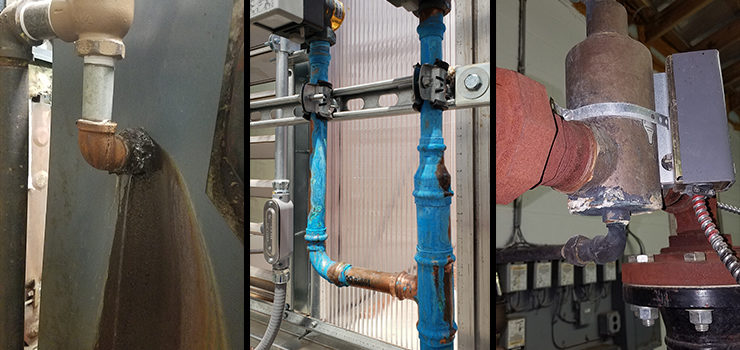
By: Richard Zalepa
Using antifreeze in hydronic systems is a necessary evil, when the application calls for it. Our company, Patriot Pool Heating Co., uses antifreeze more often than most heating contractors, and we’ve learned a thing or two along the way.
Contrary to what the company name suggests, we’re actually a full-service HVAC contracting company; residential and commercial. So our use of antifreeze in hydronic systems goes beyond pool heating. We provide freeze protection for commercial chiller systems, snowmelt loops, old houses with poor insulation, vacation homes, or literally any application where there’s a possibility of freezing. Antifreeze in a hydronic system is insurance, but only if done correctly. If it’s done improperly, it can quickly become a liability.
There are two things that I cannot stress enough when using antifreeze: A) Systems must be specifically designed for the use of antifreeze, and B) Systems with antifreeze must be maintained!
We’ll cover maintenance in more detail later, but it’s worth mentioning right now that all hydronic system antifreeze chemicals require annual maintenance and testing. Not only does freeze protection decline over time if not maintained, but antifreeze can and will turn caustic (acidic) if neglected. The pH of the system fluid must be tested and balanced. If left to its own devices, antifreeze will destroy a hydronic system.
Types of antifreeze
The vast majority of the antifreeze that we use is Hercules Cryo-Tek propylene glycol. We prefer it because it’s readily available and easy to use. The refractometers sold at your local auto parts store works with propylene glycol solutions, so you don’t need a proprietary refractometer. This is a hand-held device that tests the level of freeze protection a water/glycol solution provides. While all antifreeze chemicals require maintenance, propylene glycol probably requires the least.
There are other antifreeze chemicals which can be used in a system, like ethylene glycol or potassium formate. Propylene alternatives like these are sometimes used in chiller installations, or where food grade designations are needed. In our experience, these chemicals either require proprietary testing equipment or need to be maintained more frequently, so we avoid using them if possible. In fact, we’ve found that potassium formate is caustic at higher concentrations, even when properly maintained, and I’m not aware of a refractometer that works with it. I’m sure there are applications for this antifreeze, but it’s not for the average heating contractor.
Ethylene glycol is used in some food industry applications. We’ve found that it turns acidic more quickly than propylene. I’ve seen a cast iron boiler rot out in less than a decade because the ethylene glycol solution within the system wasn’t maintained. Also, I have not come across an ethylene product that includes a rust inhibitor, which is almost standard across the propylene chemicals available to our industry. Also, be aware that ethylene glycol is also highly toxic and can be fatal in low concentrations if ingested.
System design
Hydronic systems must be designed for the inclusion of antifreeze. It’s equally important as knowing how much pipe and radiation is part of the system.
Using antifreeze requires two big considerations during the design process:
- Propylene glycol has a lower BTU carry capacity than water.
- Glycol is more viscous than water, making it harder to pump.
Using a glycol solution in a hydronic system will lower the BTUs that the system fluid can carry. This must be taken into consideration when sizing all system components, especially the radiation. Once you exceed a concentration of 25 percent, the reduction in BTU capacity is rather significant. Losing 5 to 10 percent is pretty common.
We use LoopCad software to design most of our systems. This program allows the user to input whether or not glycol is being used, and at what concentration. It sizes all system components accordingly.
As I mentioned, using antifreeze increases the viscosity of system fluid. Water has a viscosity of 1. Typical hydronic fluid with a glycol mixture could have a viscosity 1.4 or 1.6, depending on the concentration. Because this increases head requirements, pumps must be sized accordingly. Compare the pumping requirements of your system to the pump curves provided by circulator manufacturers to select an appropriate model.
There are several other design considerations. Make sure that all of the parts in your system are rated for use with a higher glycol solution. Some may not be. For example, ProPress fittings are not rated for use with glycol solutions over a certain concentration, but this varies depending upon the application.
Further, automatic air vents and glycol do not play well together, regardless of brand, style or size. In my experience, automatic air vents rarely self-seal once they’ve come in contact with antifreeze. When laying out your boiler system, be mindful of where your bleed points are. They should be readily accessible, and all vents should have isolation valves so that they can be easily replaced and or isolated after the system is purged of all air.
Air elimination is more difficult on a system filled with antifreeze. We painstakingly bleed these systems and then close the air vents. We also replace the air vents more frequently than we do in systems without antifreeze.
Finally, we install as many non-ferrous components as possible. Neglected, acidic antifreeze will attack all metal components, but ferrous metals are damaged first.
Picking a concentration
It’s important to know how much antifreeze a system needs. This is largely determined by how cold your area gets, and the level of exposure that the pipes in the system have.
Most antifreeze buckets will feature two numbers that correspond to different concentrations; the temperature at which the system fluid will freeze, and the temperature at which the system fluid will burst pipes and components. The freeze point is the temperature at which ice crystals first form. This does not mean that the solution will freeze solid at that temp, but that can happen.
Our systems, in New York and Pennsylvania, are at lower risk of freezing than a system in, say, Fairbanks, Alaska, so we generally select a glycol concentration for a worst-case scenario of 20°F freeze point which generally offers burst protection to -10°F in southern areas of our territory and slightly lower freeze and burst points in more northern areas of our territory.
Many installers use concentrations that protect against freezing, rather than bursting. We prefer to protect against bursting. The higher the concentration, the more pronounced the negative effects of antifreeze are (the need for maintenance, higher head, lower BTU transfer, etc.). Our goal is to protect against damage to the system while also offering the highest system performance. Protecting from a burst and the subsequent property damage is our concern.
Make-up water
Using any antifreeze product in a boiler system creates an additional consideration for designers and installers; the need to provide make-up water appropriately.
Imagine if a boiler filled with antifreeze solution was equipped with a conventional feed valve, and developed a slow leak. Over time, the concentration of antifreeze in that system would grow weaker, lowering its ability to protect the system. This is one reason that systems filled with antifreeze can’t feature a feed valve.
The other issue is that most municipalities require a system with antifreeze to be equipped with a double backflow preventer between the system and the potable water supply. That said, all municipalities prefer to see a system feeder that is completely disconnected from the water supply.
Glycol feeders are vessels that are hand-filled with glycol solution. We always install a feeder so that we can visually inspect the system fluid level, so that we can fill the system with antifreeze solution instead of pure water, and so that we have an alarm on the system. The Axiom feeders we use feature an alarm contact, which we wire to the boiler control to shut the boiler down in the event that the feeder runs dry.
Maintenance
I can’t overstate the need to maintain a boiler system with antifreeze. Our annual maintenance regimen includes pH testing of system fluid. A pH of 8.5 is generally recommended, but refer to the boiler I&O manual for a safe Ph range. Testing is conducted with litmus strips sold by the manufacturer of the antifreeze.
If we find that the fluid is acidic, we add corrosion inhibitor to the system. After allowing the system to circulate for half an hour or more, the pH test must be conducted again.
We also use a refractometer to make certain that our level of freeze protection is still on target. If we discover that we need more protection, we’ll add antifreeze to the system.
Once we’re certain that the system fluid is in good shape, we check that there is no air in the system, and then close all the auto air vents in the system.
Using antifreeze in a hydronic system adds upfront and maintenance cost, but those are grossly outweighed by benefits in situations where there is any freeze potential.
As with all HVAC systems, creating a functional, long-lasting antifreeze system starts in the design phase, and relies on diligent maintenance. Do this, and your customers will be happy with the product, even in the event of a severe weather event.

